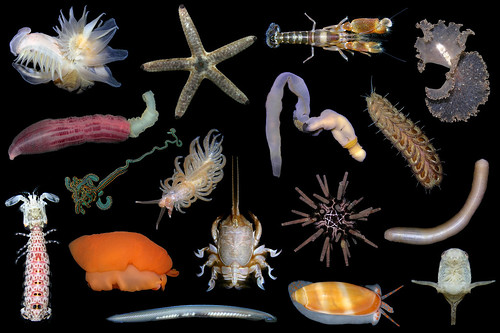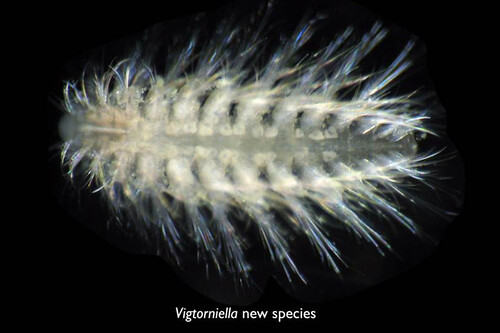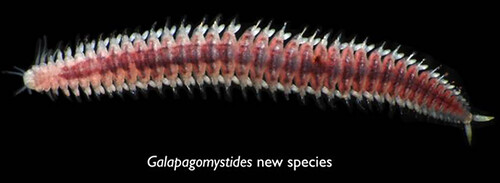It surprised me that SO MANY have since become established. I remember many years ago when it was less than 6 people and most of it was secondary to blogging!
Now, not ONLY are there many, MANY IZ Twitter themed accounts specializing on specific taxa, there are actually REGULAR twitter events...
Invertebrate Themed Twitter Events
Weekly..
#MolluskMonday or #MolluscMonday. Yup. Snails. Cephalopods. Scaphopods. Whatever mollusks you like? EVERY Monday. Do it.
#TrilobiteTuesdays. Held every Tuesday. If you are into Paleozoic arthropods then Tuesdays are YOUR thing!
#WormWednesday: Held every Wednesday. These bring forth all manner of worm-like phyla: Polychaeta, Annelida, Nematoda, Platyhelminthes, Acoela, and so on and so forth..
#SpongeThursday: Held every Thursday. Love the Porifera? the Hexactinellida? Go forth and
enjoy/post about them!
Honorable mention goes to #FossilFriday which is mostly about Dinosaurs and vertebrates..but you get some ammonites and other invertebrates in there pretty regularly...
Yearly..
#CephalopodAwarenessWeek. aka #CephalopodAwarenessDays Every year from October 8 to 12. You can keep on updates at @cephalopodday. Basically 5 days celebrating EACH class of cephalopods and then some...
- October 8 – Octopus Day, for all the eight-armed species
- October 9 – Nautilus Night, a time for all the lesser-known extant cephalopods
- October 10 – Squid Day/Cuttlefish Day, or Squidturday, covering the tentacular species
- October 11 – Myths and Legends Day, for all the fantastical cephalopods of movies, literature and legend.
- October 12 – Fossil Day
#SeaSlugDay. Held every year on October 29th in honor of Dr. Terry Gosliner's birthday! Celebrate by posting images, videos and links to all manner of shell-less marine gastropods! Nudibranchs and their kin! My post from last year.
And of course #Okeanos when the NOAA vessel Okeanos Explorer goes into research/streaming mode! in which case, there are new deep-sea invertebrate posts for several hours every day for about 2 to 3 weeks!!
Various Twitter accounts/Persons with Invertebrate themed content
 |
| from the USNM Invertebrate Zoology FB page @InvertebratesDC |
This will be a fairly subjective list-I focused mainly on marine groups and those with academic or otherwise focused content that I thought was appropriate. Activity was also a consideration. Some accounts looked essentially inactive and were not included.
Let me clear that there are a LOT of accounts which have a broader focus that regularly include Invertebrate Zoology themed tweets, including aquariums, natural history museums, etc. and frankly those have so many followers its unnecessary to give them much more publicity anyway..
There were MANY, many individual accounts of photographers, naturalists, educators, scientists, etc. who for one reason or another I just couldn't include for the sake of space, focus, etc.
And there are some topics, for example about coral reefs, there's a TON of coral-related accounts and I simply could not list them all... A search on Twitter's search engine will get you all of those names pretty quickly though.
So, please don't take an omission as an offense. In fact, if you've got an IZ twitter account that you'd like me to know about, please let me know and if I think its appropriate, I'd be happy to include it.
As a side note: my search for these Twitter accounts took me to some interesting places and its curious to see how many of of the phylum or other taxonomic names have made it into popular use: band names, student groups, social clubs, business organizations, video games, so on and so forth...
General Accounts:
Invertebrate Zoology department of the NMNH at the Smithsonian @InvertebratesDC The official account for one of the most active Invertebrate Zoology departments in the world.
Heidi Gartner. @RBCMInverts. Collection Manager at the Royal British Columbia Museum Invertebrate Zoology dept.
Annelida & Segemented Worms
Dr. Christoph Bleidorn @C_Blei. Evolutionary biologist at the MNCN in Madrid
Dr. Conrad Helm. @conrad_helm. Sars International Center at the University of Bergen. Works on the systematics of segmented worms.
Brachiopoda
Brachiopod research at the Natural History Museum in London @NHM_Brachiopoda.
Bryozoa
Bryozoan research at the Natural History Museum in London @BryozoanNHM This is, I daresay, the finest Twitter account about bryozoans I have seen to date!! Both fossil and living!
Cnidaria
Dr. Allen Collins, NMFS/Invertebrate Zoology NMNH. @tesserazoa. Specialist in jellyfish systematics, sponges and metazoans relationships.
Australian Coral Reef Society. @AustCoralReefs. Official twitter account of the Australian Coral Reef Society.
Dr. Casey Dunn, Brown University. @caseywdunn. Evolutionary biologist at Brown with a special eye towards siphonophores! He also produces Creature Cast videos.
Dr. Cheryl Lewis Ames, @boxjellytalk. NMNH/University of Maryland, box jelly expert.
Coral Morphologic. @CoralMorph. Strong visuals, images, videos of cnidarians and many other invertebrates.
Gates Lab @GatesCoralLab. Coral Research at the Hawaii Institute of Marine Biology.
Dr. David Plachetzki. University of New Hampshire. @plachetzki. Cnidarian genomics.
Dr. Mercer R. Brugler @ProfBrugler. Professor at City Tech, SUNY, Taxonomy & Systematics of Black Corals & Anemones.
Medusozoa Columbia. @Medusozoacol. Jellyfishes of Columbia!
NOAA Coral Program @NOAACoral. Official Twitter account for the NOAA Coral Reef Conservation Program.
Dr. Rebecca Helm. @RebeccaRHelm. Woods Hole Oceanographic Instition. Jellyfishes and all manner of swimming cnidarian.
Dr. Paulyn Cartwright @pcart. Professor at the University of Kansas specializing in Cnidarian Evolution.
Dr. Andrea Quattrini. @quattrinia. Harvey Mudd College. Studies deep-sea corals.
Crustacea
Miranda Lowe, @NatHistGirl. Principal curator of Marine Invertebrates at the Natural History Museum in London.
Dr. Tammy Horton, Amphipod taxonomist at the Discovery Collections in Southampton @tammy_horton.
Adam Hadsall. @_Nezumiiro_ Tweets #craboftheday and many other items of carcinological interest!
Echinodermata
Chris Mah, Research Associate at the NMNH. @echinoblog. I work on sea stars but know stuff about things.
David Clark. @Clarkeocrinus. A great account for enjoying Paleozoic and fossil stalked crinoids!
Fossil Worms (Miscellaneous)
Luke Perry. At the University of Bristol in the UK/Natural History Museum. @Cambriannelids. Works on Cambrian worms, primarily annelids.
Hemichordates, deuterostomes, etc.
Dr. Chris Cameron. @InvertEvo at the University of Montreal. One of my colleagues who studies the evolution and development of deuterostomes, especially hemichordates.
Invertebrate Paleontology
Dr. Dave Rudkin, @RudkinDave. Royal Ontario Museum. Studies Paleozoic arthropods and other fossil invertebrates.
Invertebrate Vision
Dr. Michael Bok at the University of Hawaii @mikebok. Studies Vision in invertebrates.
Leeches (Hirudinea)
Dr. Anna Phillips, Curator of leeches and parasitic worms at the NMNH, Smithsonian. @Annalida500.
Dr. Mark Siddall Curator at the American Museum of Natural History. @theleechguy.
Dr. Sebastian Kvist, Curator at the Royal Ontario Museum. @sebastian_kvist. Annelid & leech systematics.
Mollusks-Bivalves
Dr. David Hayes. @Gnarly_Larvae at Eastern Kentucky University. Works primarily on molecular ecology and freshwater mussels.
Freshwater Mussels. @WeNeedMussels. What more can you ask for? A Twitter account entirely devoted to Freshwater mussels!
Mollusks-Cephalopods
ALCES: The AUT Lab for Cephalopod Ecology and Systematics. @ALESonline. Devoted to studying cephalopod biology, especially deep-sea squids
Research account for fossil cephalopods at the Natural History Museum in London. @NHM_cephalopoda
CIAC-The Cephalopod International Advisory Council. @cephCIAC. The Cephalopod International Advisory Council is a scientific group for cephalopod researchers worldwide
Dr. Louise Allock. @DrShmoo at the National University of Ireland, Galway. Deep-sea octopuses!
The Octopus Newsletter Online (TONMO) @cephs A hub for cephalopod research and interest.
Dr. Stephanie Bush, Monterey Bay Aquarium. @podlett. Deep-sea Octopus biologist/systematist at MBA.
Mollusks-Gastropoda (shelled snails & slugs)
Dr. Chong Chen, Biologist at JAMSTEC who works on deep-sea snails @squamiferum.
Jessica Goodheart. @sluglife28. PhD student at the University of Maryland/NMNH. Studies sea slug systematics and behavior.
Dr. Kevin Kokot, @kmkocot. University of Alabama. Mollusk & metazoan phylogeny.
Nematode Worms
The Blaxter Lab (Dr. Mark Blaxter, University of Edinburgh),@blaxterlab. Nematode, tardigrade and other invertebrate genomics/genetics.
Nemerteans (Ribbon Worms)
Dr. Jon Norenburg, dept. chair of the Invertebrate Zoology dept. at the NMNH. @Jnorenburg and @nemertinator (personal account) Specializes in ribbon worms and meiofauna.
Iberian Nemerteans. @nemertan. Truth in advertising. A Twitter account about ribbon worms based in Spain.
Parasites (broadly)
Twitter account for the American Society of Parasitologists @AmSocParasit All parasites. All the time.
Tommy Leung, Parasitologist who authors the "Parasite of the Day" blog. @The_Episiarch
Pelagic Invertebrates
Leann Biancani, @LeannMBiancani PhD student at the University of Maryland and the NMNH. Studies the biology and relationships among pelagic invertebrates, including amphipods and polychaetes.
Dr. Steve Haddock, MBARI. @beroe Dr. Haddock is an expert in ALL manner of pelagic deep-sea invertebrates.
Dr. Richard Kirby, based in Plymouth, United Kingdom. @planktonpundit. A wonderful account with regular images and videos of planktonic/nektonic and other related organisms.
Platyhelminthes & Flatworms
Dr. Ulf Jondelius @ulfjo, specializes in aceolomorph "flatworms" at the Swedish Museum of Natural History.
Dr. Jean-Lou Justine, specialist on free-living land flatworms at the MNHN in Paris. @Plathelminthe4 If you are REALLY into Bipalium and other terrestrial, free living flatworms this feed is for you!
Polychaete Worms
UPDATE: Christoph Bliedorn has produced a magnificent list of Tweeting Polychaetologists here: https://bembecinus.wordpress.com/2016/10/05/a-list-of-tweeting-polychaetologists/
The Polychaeta Database @WpolyDB Twitter account of the World Polychaete Database (WoRMS)
ケムシ屋 @alciopidae. I don't have a full name unfortunately. A Japanese polychaete taxonomist (Cirratuliformia/Alvinellidae/ Myzostomida/Opheliidae/Polynoidae etc...)
Dr. Helena Wiklund. @helena_wiklund, University of Gothenberg, Germany. Polychaetes and annelid diversity.
Maddie Brasier. @Madsbrasier. Studying Antarctic polychaetes.
Dr. Shinri Tomioka. @Capitellico PhD student at Hokkaido University in Japan studying polychaetes.
Dr. Torkild Bakken. @TorkildBakken. Marine biologist at NTNU University Museum, polychaetes and other deep-sea diversity.
Porifera (the sponges)
Twitter account for deep-seasponges.org @Deepsea_sponges You don't get much more specific than this, where deep-sea Porifera are concerned!
Dr. Jackson Chu @jwfchu. Glass sponges and benthic ecology.
The Pawlik Lab @PawlikLab at the University of North Carolina, Wilmington. Sponge chemical ecology and biology.
Dr. Ana Riesgo at the Natural History Museum in London. @anariesgogil Sponge researcher at the British Museum.
Dr. Bob Thacker at Stony Brook University. @thackerbob Ecology and systematics of sponges, Involved with the Porifera Tree of Life Project.
Protists!
The International Society of Protistologists! @protistologists . Pretty much all in the title.
Psi Wavefunction.@PsiWavefunction. Protist blogger and scientist.
Tardigrades
Dr. Daiki Horikawa. University of Tokyo. @daikidhori Tardigrade biology & genomics!























